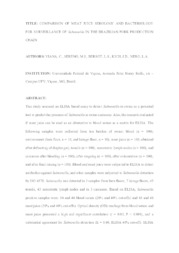Comparison of meat juice serology and bacteriology for surveillance of salmonella in the brazilian pork production chain.
Comparison of meat juice serology and bacteriology for surveillance of salmonella in the brazilian pork production chain.
Autoria: VIANA, C.; SERENO, M. J.; BERSOT, L. dos S; KICH, J. D.; NERO, L. A.
Resumo: Abstract: This study assessed an enzyme-linked immunosorbent assay (ELISA) based assay to detect Salmonella in swine as a potential tool to predict the presence of Salmonella in swine carcasses. The following samples were collected from 10 swine batches: blood (n = 100); environment (barn floor, n = 10, and lairage floor, n = 10); meat juice (n = 100, obtained after defrosting of diaphragm); tonsils (n = 100); mesenteric lymph nodes (MLNs) (n = 100); and carcasses after bleeding (n = 100), after singeing (n = 100), after evisceration (n = 100), and after final rinsing (n = 100). Blood and meat juice were subjected to ELISA to detect antibodies against Salmonella, and other samples were subjected to Salmonella detection by ISO 6579. Salmonella was detected in 3 samples from barn floors, 7 lairage floors, 45 tonsils, 43 MLNs and in 3 carcasses. Based on ELISA, Salmonella positive samples were: 86 and 46 blood serum (20% and 40% cut-offs) and 68 and 46 meat juice (20% and 40% cut-offs). Optical density readings from blood serum and meat juice presented a high and significant correlation (r = 0.93, p < 0.001), and a substantial agreement for Salmonella detection (K = 0.69, ELISA 40% cut-off). The agreement between ELISA and microbiological analysis for Salmonella detection in pig carcasses were absent or poor, with the exception of results obtained by ELISA 40% cut-off from blood serum and meat juice with MLNs (K = 0.49 and 0.50, respectively) and tonsils (K = 0.29 and 0.30, respectively). Based on the obtained results, meat juice can be considered an alternative to blood serum as a matrix for ELISA for preliminary detection of Salmonella, allowing the identification of potential sources of contamination during slaughtering.
Ano de publicação: 2020
Tipo de publicação: Resumo em anais e proceedings
Unidade: Embrapa Suínos e Aves
Observações
1 - Por padrão são exibidas publicações dos últimos 20 anos. Para encontrar publicações mais antigas, configure o filtro ano de publicação, colocando o ano a partir do qual você deseja encontrar publicações. O filtro está na coluna da esquerda na busca acima.
2 - Para ler algumas publicações da Embrapa (apenas as que estão em formato ePub), é necessário ter, no celular ou computador, um desses softwares gratuitos. Sistemas Android: Google Play Livros; IOS: iBooks; Windows e Linux: software Calibre.
Acesse outras publicações
Acesse a Base de Dados da Pesquisa Agropecuária (BDPA) para consultar o acervo completo das bibliotecas da Embrapa.

